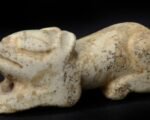In the serene fields of Cambridgeshire, a remarkable discovery has brought the whispers of ancient Celtic civilization to the forefront of modern archaeology.
The Discovery
In September 2018, the tranquility of Little Chishill was pierced by the beep of a metal detector, heralding a find that would intrigue historians and locals alike. Bob Jemmett, a retired lorry driver and metal detecting enthusiast, unearthed a small bronze figure with an oversized phallus, immediately recognizable as a symbol of fertility from a bygone era.
The figure, measuring a mere 37mm by 10mm, is believed to date back to the first century B.C.E., offering a tangible connection to the Celtic people who once roamed these lands. Dubbed ‘Nobby’ by Jemmett, this artifact has since been his constant companion, accompanying him on further quests through the English countryside.

Symbolism and Significance
Celtic fertility figures are rare finds, with ‘Nobby’ bearing a striking resemblance to the Cerne Abbas Giant—a renowned hill figure in Dorset. Such symbols were often associated with prosperity and success in agriculture, reflecting the Celts’ reverence for nature’s bounty.
The exaggerated features of ‘Nobby’ are not merely artistic expressions but serve as a window into the beliefs and rituals of our ancestors. Fertility was a central theme in Celtic spirituality, with deities like Cernunnos embodying virility and strength.
The Auction
After six years of guardianship, Jemmett has decided to part ways with ‘Nobby’, not out of disinterest but in pursuit of practicality—he plans to use the proceeds from the auction to make improvements to his home. This decision brings ‘Nobby’ into the public eye, offering collectors and institutions a chance to preserve and study this piece of Celtic heritage.













